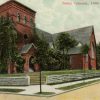calsfoundation@cals.org
Henry Niles Pierce (1820–1899)
Henry Niles Pierce was the fourth bishop of the Episcopal missionary jurisdiction of Arkansas and Indian Territory, and the first bishop of the Episcopal Diocese of Arkansas.
Henry Niles Pierce was born on October 19, 1820, in Pawtucket, Rhode Island, to Susan Walker Pierce and Benjamin Bentley Pierce, a tanner, currier, and deacon of First Baptist Church. Pierce attended Portsmouth High School and graduated from Brown University in 1842. He studied theology under Dr. Francis Vinton and Rev. George W. Hathaway, both of Rhode Island. Initially, Pierce intended to become a minister of the Baptist faith practiced by his family; however, his personal beliefs aligned more closely with those of the Episcopal Church.
Upon his physician’s recommendation to seek a warmer climate, in the fall of 1846, Pierce traveled to Florida. In 1848, he relocated to Matagorda, Texas, where he was ordained a deacon on April 23, 1848, and was admitted to the priesthood on January 3, 1849, by Bishop George Washington Freeman at Christ Episcopal Church. He conducted missionary work at St. Paul’s in Washington, Texas, from 1849 to 1852, during which he founded the churches of St. Peter’s, Brenham, and St. Paul’s. In 1852, Pierce returned to Matagorda as rector of Christ Episcopal, a position he held for two years. He then held a succession of appointments as a rector for Episcopal churches across the United States: Trinity in New Orleans, Louisiana, 1854; St. Paul’s (now the Church of the Good Shepherd) in Rahway, New Jersey, 1855–1857; St. John’s in Mobile, Alabama, 1857–1868; and St. Paul’s in Springfield, Illinois, 1868–1870. According to one of Pierce’s daughters, he and a Catholic priest were the only clergy to remain in Mobile during the summer of 1858 yellow fever epidemic.
Pierce met Nannie Haywood Sheppard (1830–1899), the daughter of a wealthy sugar planter, while rector at Christ Church in Matagorda. The couple married on April 18, 1854, and had four children: Wallace Abraham Pierce, who also became a member of the Episcopal clergy; Henry Niles Pierces Jr.; Elizabeth Pierce Lyman; and Susan Sheppard Pierce Stevens.
Pierce arrived in Little Rock (Pulaski County) on a steamboat from Memphis, Tennessee, in March 1870 after being consecrated bishop of the diocese on January 25, 1870, in Mobile, Alabama. He called a convention of Arkansas Episcopal clergy and lay delegates in 1871 for the purpose of organizing a statewide diocese; at the convention, Pierce was unanimously elected bishop of the new Diocese of Arkansas. He retained the bishopric of the missionary jurisdiction of Indian Territory until 1893, when the area became part of the missionary district of Oklahoma and Indian Territory.
The establishment and construction of Trinity Episcopal Cathedral was largely due to the efforts of Pierce. After nine years as missionary bishop, Pierce recognized the need for a cathedral in Little Rock. When Christ Church declined cathedral responsibilities, Pierce began raising money for construction of a new building. By 1882, he had enough money to purchase the land at the corner of 17th and Spring streets. The cathedral was opened on October 19, 1884, Pierce’s birthday.
Pierce and his family initially boarded with the family of Gilbert Knapp at 7th and Rector before renting the Christ Church rectory, at 220 Cumberland, on the northeast corner of East 7th and Cumberland, where they remained until 1881. Nannie Pierce purchased two lots at 17th and Center streets, where the couple built a home, across from the land where Trinity Episcopal Cathedral was constructed several years later.
Pierce died on September 5, 1899, in Fayetteville (Washington County) after an illness of ten days. He was buried in Oakland Cemetery in Little Rock. He was succeeded as bishop upon his death by William Montgomery Brown.
For additional information:
Henry Niles Pierce Papers, 1869–1876. Archives of the Episcopal Diocese of Maryland. Episcopal Diocesan Center, Baltimore, Maryland.
Lyman, Elizabeth Pierce. “History of Trinity Cathedral.” Unpublished brochure, 1934.
McDonald, Margaret Simms. White Already to Harvest: The Episcopal Church in Arkansas, 1838–1971. Sewanee, TN: University Press of Sewanee, 1975.
Sarah Bost
UALR Center for Arkansas History and Culture
 Civil War through Reconstruction, 1861 through 1874
Civil War through Reconstruction, 1861 through 1874 Religion
Religion Trinity Episcopal Cathedral
Trinity Episcopal Cathedral Henry Niles Pierce
Henry Niles Pierce 



Comments
No comments on this entry yet.